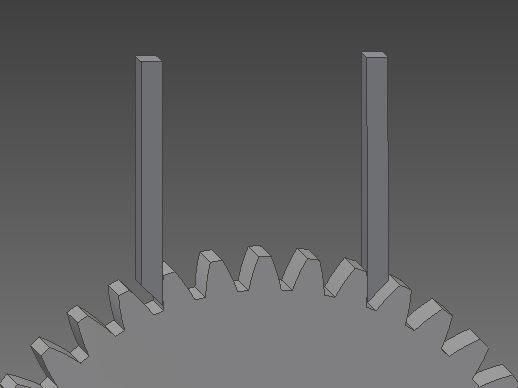If you have a gear and need to replace it or match to it (for example to make a missing change gear for your lathe) here is how to do it.
(Most of this isn't new, but I think that the pressure angle table is)
There are two main standards for gears, imperial and metric.
To buy or make a gear you need the number of teeth (N) the tooth size (DP or MOD) and the pressure angle (PA).
PA is generally 20° in modern applications, but was generally 14.5° early in the 20th century, and could be either mid-century.
Designers use the Pitch Circle Diameter (PCD) to design geartrains, but that's in the middle of the teeth and can't be directly measured.
For metric (module, or mod) gears the PCD is N x MOD
For imperial (DP) the PCD is N / DP.
The OD of a gear is the PCD + the "Addendum" which is normally 1 module (or 1" / DP) per tooth, so 2 modules extra on diameter.
So, to identify a gear.
1) Count the teeth. = N
2) Measure the OD in mm and divide by (N + 2) = MOD
3) Divide (N + 2) by the OD in inches = DP
4) DP is generally an even number, MOD is usually an integer down to 3, then goes by 0.5, 0.25 or 0.1. Pick the most likely.
4a) Gears can be "profile shifted" to improve the geometry when the ratio is large, or if the centre distance is critical, and not easy to change. Note this deviation from the theoretical OD.
5) (The main point of this email) To measure the Pressure Angle (PA) measure the span across the flanks of 4 teeth (or 3 on a smaller tooth-count gear) with a digital caliper and zero it.
Then measure the span over 1 fewer teeth, and over one more teeth. That should give the same number both times (one being negative, of course.) Refer to the table below to determine the most likely PA.
->VVVV<- would be the span over 4 teeth. The caliper jaws need to be on the sides of the teeth, not the tip.
DP 14.5° 20°
4 19.314 18.746
6 12.876 12.497
8 9.657 9.373
10 7.725 7.498
12 6.438 6.249
14 5.518 5.356
16 4.828 4.687
18 4.292 4.166
20 3.863 3.749
22 3.512 3.408
24 3.219 3.124
26 2.971 2.884
28 2.759 2.678
30 2.575 2.499
MOD 14.5° 20°
8 24.32 23.617
6 18.249 17.713
5 15.208 14.761
4 12.166 11.809
3 9.125 8.856
2.5 7.604 7.380
2 6.803 5.904
1.75 5.323 5.166
1.5 4.562 4.428
1.25 3.802 3.690
1 3.042 2.952
0.9 2.737 2.657
0.8 2.433 2.362
0.75 2.281 2.214
0.7 2.129 2.066
Dave S.





